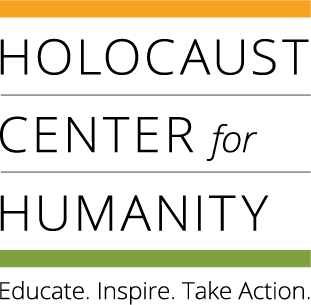
Image: Group photo of partisans from the Vilna Ghetto. Lithuania, circa 1942-1944. Courtesy United States Holocaust Memorial Museum.
Common Core State Standards as addressed by this Overview Lesson
Resistance
In the face of Nazi terror, many Jews resisted the Germans and their collaborators.
In ghettos throughout Nazi-occupied Europe, Jews defied the indignity and dehumanization of Nazi terror through spiritual resistance and attempts to preserve their communal and cultural life. They held clandestine religious services, established schools and libraries, and maintained cultural traditions through secret publications, lectures and performances. Secret archives of art and written documentation recorded conditions in some of the ghettos. Underground networks of forgers and smugglers supplied life-saving official documents and food to people in ghettos and in hiding throughout Europe.
Organized armed resistance, though, was the most direct form of Jewish opposition to the Nazis. In western Europe, Jewish partisans smuggled endangered people to safety and aided those in hiding. They also joined non-Jewish resistance units and sabotaged German military operations. Despite minimal support and even hostility from local populations, armed resistance units also formed in more than 100 ghettos. In April 1943, the Jews of Warsaw, outgunned and outnumbered, launched the largest ghetto uprising. After almost a month, the Germans suppressed the uprising. Jews fought the Germans both in the ghettos and behind the front lines in nearby forests. In many cases, resistance members also joined partisan units outside the ghettos of Eastern Europe. Prisoner revolts even took place in Nazi camps, including 1943-1944 uprisings in the Treblinka, Sobibor and Auschwitz-Birkenau killing centers.
The spirit of these and other efforts transcends their inability to halt the genocidal policies of the Nazis.
There was also a variety of non-Jewish groups which offered resistance to the Nazi regime, both in German and in German-occupied territory.
Examples of non-Jewish resistance include:
- Among the earliest domestic opponents of Nazism were Communists, Socialist and trade union leaders.
- Dietrich Bonhoeffer, a German theologian, broke from mainstream church hierarchies that supported or acquiesced to the Nazi regime by opposing it.
- There were several failed assassination attempts against Hitler.
- The White Rose, a small resistance group of Munich university students, sought to directly expose Nazi atrocities against Jews and the country itself, and to urge Germans to actively oppose the Nazi regime.
- French General Charles de Gaulle openly refused to swear allegiance to the Nazi-supporting Vichy regime and advocated open resistance. Resistance movements there committed acts of sabotage and assaults on German officials.
- Resistance movements also formed in countries like Denmark, Norway and the Netherlands, resulting in raids, sabotage and the murder of informants.
- In May 1942, Czech agents assassinated Reinhard Heydrich, the architect of the plan for the “Final Solution” of the Jewish question.
- Armed partisan resistance was widespread, particularly in the Soviet Union.
- In August 1944, Poles mounted an uprising against the German occupation. There was also non-violent resistance, including sheltering Jews and listening to forbidden Allied radio broadcasts.
Holocaust Survivor Video Testimony Clips
The survivors featured below live or have lived in Washington State. The country listed in parentheses is the country in which they were living during the Holocaust. These survivors, with their history and stories, have shaped our community, contributing to its richness and diversity. They challenge us to understand history through personal narrative - to see complex human beings behind the facts.
Questions
1. Resistance comes in many forms, both violent and non-violent. Consider/discuss the many factors which may lead an individual or group to resist an oppressive regime.
2. What risks might a group or individual face when resisting the actions of government or society?
3. How did the risks of resistance to the Nazis differ from country to country and/or as the war proceeded?
4. Ed Kaye and Thomas Blatt both discuss that it’s important for people to learn and know about what they and others did to resist the Nazis. Why do you think this is so important to them?
